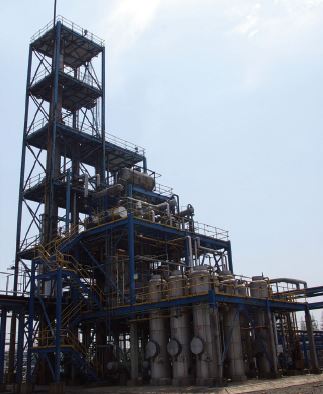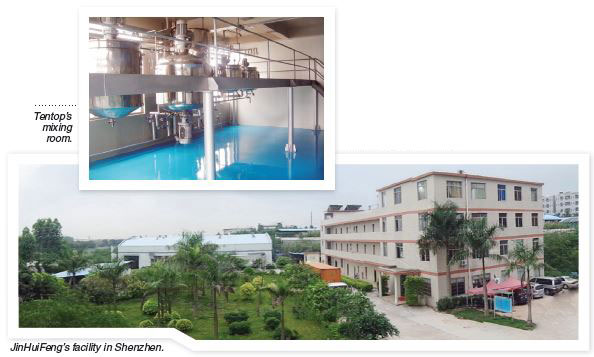Written on: July 1, 2012 by SprayTM
 In China, aerosol contract filling is a relatively new business that is being recognized and accepted gradually. For a better understanding of it, we need to review the history of the development of Chinese aerosol manufacturing.
In China, aerosol contract filling is a relatively new business that is being recognized and accepted gradually. For a better understanding of it, we need to review the history of the development of Chinese aerosol manufacturing.
Aerosols have been made in China since the late 1950s (and perhaps surprisingly, the first manufacturer was yours truly). At the end of the ’50s, the whole country was in the progress of the “Great Leap Forward” and some shipyards in Shanghai needed aerosol flaw detectors, lubricants and other important aerosol products not available on the market at that time. For this reason, shipyards decided to make those aerosols by themselves. Jiangnan Shipyard and the others established a company whose sole responsibility was to produce aerosol products, using equipment and valves they manufactured themselves.
Aerosol insecticides today comprise 30%-40% of China’s aerosol industry, and the first company to research this was pesticide supplier Shanghai United Chemical Co., who manufactured the first aerosol insecticide in China: Pin-Jing. Later, Zhongshan Shiqi Pesticide Factory produced another well-known aerosol insecticide: Miehailing.
These examples portray the predominant feeling of self-reliance that people in China had at this time. During this period, it was impossible for the Chinese to entrust aerosol filling to those outside the country, and these circumstances lasted almost 40 years.
However, in the middle of the 1990s, to speed up the elimination of CFCs from aerosols, the Multilateral Fund of the Montreal Protocol subsidized the establishment of two aerosol filling centers in China: one in Shanghai and the other in Tianjin. The two centers utilized Pamasol aerosol filling lines and related equipment. Due to a lack of contract filling knowledge, the two centers were closed due to lack of business. The center in Shanghai was transferred to a privately owned company and the equipment from Tianjin was sent to an aerosol company in Guangzhou.
As time went by, a huge change occurred; nowadays, there are many aerosol contract filling companies with all kinds of product ranges in China, in areas such as Guangdong in the south, Zhejiang and Shandong in the east and Hebei and Tianjin in the north. Their filling volume increases year by year, and currently accounts for approximately one-third of aerosol production for China.
What’s the reason of such huge change? First of all, there was an introduction of laws and regulations. As the “New Age” dawned, the government introduced a series of laws, regulations and standards to strengthen production safety and protect the environment. Those companies that produced and sold hazardous chemicals had to conduct safety and environmental assessments before setting up. For these reasons, the investment in establishing a qualified factory increased sharply, and many companies chose contract filling instead of filling aerosols themselves.
Second, the increase of transportation costs of dangerous goods convinced marketers and brand owners to process goods nearby their target markets to decrease costs. S.C.Johnson Ltd. has an aerosol production base in Shanghai, but still chooses contract filling in Foshan for its products sold in the southern market. Chepu in Shenzhen is a supplier of car accessories and car care products, and now fills its products for the northern market in Shandong, which saves transportation costs on nearly 2,000kms (1,243 miles).
The number of foreign marketers that manufacture aerosols in China and then either sell locally or back to their own countries has increased over the years. They come from Japan, the U.S., Southeast Asia, the Middle East and Europe, and their products include all kinds of aerosols.
Aerosol contract filling ventures have the following characteristics:
• Most settle by a nearby logistics hub or port for convenient transport of products to
target markets.
• Most settle by a nearby can factory and propellant supplier to save transportation costs;
some manufacture aerosol cans in-house, such as Laya, AESTAR and Meiduo.
• The cost of producing decreases from south to north while R&D capabilities increase from north to south.
• Some enterprises, such as Rainbow, Botny and Ludao, produce their own brand while contract filling for others.
In 2011, there were 12 enterprises whose contract filling volume was over 10 million cans:
• 50+ million cans Botny, Ludao
• 40+ million cans Laya, Meiduo
• 30+ million cans Sea(Shenzhen), Rainbow
• 20+ million cans LokKo
• 10+ million cans Aestar, Shanghai DAIZO, JinHui Feng, Tentop, SCAL
 Botny in Guangzhou is the biggest aerosol enterprise in China and fills about 120 million cans a year; about 50% of products are its own brand and the rest is contract filling. Its main products are paint, automotive care aerosols and industrial supplies. This year, it has expanded into the field of household and personal care aerosols.
Botny in Guangzhou is the biggest aerosol enterprise in China and fills about 120 million cans a year; about 50% of products are its own brand and the rest is contract filling. Its main products are paint, automotive care aerosols and industrial supplies. This year, it has expanded into the field of household and personal care aerosols.
Ludao in Zhejiang is located in Sanmen, Taizhou, about 170kms away from Ningbo Port. It is currently the second largest aerosol manufacturer in China and its main products are air fresheners and other household aerosols. This year, it’s expanding into the field of personal items and cleaning agents, and has developed a post-foaming shower gel and nano silver household cleaner. It partners with a nearby tinplate aerosol can company.
Laya in Foshan has two departments: can manufacture and aerosol filling, and produces 100 million tinplate aerosol cans a year and contract fills nearly 50 million cans. Its main product is household and car care aerosols, as well as recreational aerosols like party string.
Meiduo in Shandong also has two departments: can and aerosol. It custom fills about 50 million cans and produces nearly 130 million tinplate aerosol cans. Its main products are automotive, household and industrial aerosols. It’s located about 5kms away from the nearby Rizhao Port, Lianyungang Port, a DME production plant and LPG suppliers.
Sea in Shenzhen is one of the earliest aerosol enterprises in China and has nearly 30 years of aerosol manufacturing and R&D experience. It produces almost 40 million cans a year and its main products are personal care, household care and aerosol paint.
Aestar in Zhongshan is another one of the earliest aerosol enterprises in China. Besides aerosol, it produces tinplate cans, DME and pyrethroids and its main products are aerosol insecticide and household care. It has its own R&D center.
DAIZO in Shanghai is a member of the One Asia network and custom fills personal care and household aerosol and liquid preparations, backed by its strong R&D team. It supplies high quality personal care products to China and Japan; as a result, orders from various multinationals are growing year by year.
Lok Ko Party Fine Co. Ltd in Zhongshan mainly fills novelty aerosol products such as party string, air horns and Christmas snow. It was successful in developing a series of creative new patented party aerosols in China that meet the European Community standard, are nonflammable, non-toxic, zero ODP and low GWP(<150). Its contract filling volume was almost 30 million last year.
JinHuiFeng in Shenzhen manufactures recreational items such as party string, artificial snow and air horns. Its annual production is experiencing increased stability, although it has been continuously impacted by laws and regulations.
Tentop in Zhongshan is a rookie in the field of aerosols in China and specializes in personal care items and household aerosols. It has gained prominence after only three years and has received European and Pathogeny GWPC certification.
Shanghai CAL is a specialty manufacturer of high quality personal and household aerosols and liquid for brand owners. It also supplies pure propane, iso-butane and n-butane.
The aerosol contract filling business started later in China than in the rest of the world. It developed very slowly at the beginning, but urged on by social demands, quickly developed. As the Chinese economy developed, people’s purchasing power strengthened. Consumers had, to a limited degree, experienced the convenient advantages of aerosols and now are choosing aerosol products when they can afford them.
With the uptake in international relocation lately, the number of foreigners such as Europeans, Americans and Japanese—who stay in China for long periods of time and who use aerosols as a habit—has increased. Nowadays, there are millions of foreign people living in China and the number is growing each year. Foreign tourists also increase annually—a huge consumer group that has been targeted by famous brands formed by multinational corporations (who realize it’s in their best interest to fill their aerosols in China).
After much research and practice, aerosol contract fillers in China have improved management and equipment, as well as R&D, quality control and manufacture practices in order to provide for the demands of brands at home and abroad. Raw materials and packaging, such as aerosol cans, valves, propellants and solvents are provided with reliable quality and a favorable price. China optimistically predicts that the business of aerosol contract filling is going to enter a boom period of development and continue to promote beautification, efficiency and improved health.
